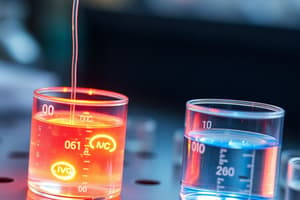Podcast
Questions and Answers
At which electrode does the oxidation reaction occur?
At which electrode does the oxidation reaction occur?
- Cathode
- Anode (correct)
- Neither anode nor cathode
- Both anode and cathode
What is the primary function of an electrolyte?
What is the primary function of an electrolyte?
- To facilitate the flow of electrons between electrodes
- To facilitate the flow of ions between electrodes (correct)
- To increase the surface area of the electrodes
- To generate a high voltage in an electrochemical cell
What type of electrode is likely to be used in an electrochemical cell where hydrogen gas is evolved?
What type of electrode is likely to be used in an electrochemical cell where hydrogen gas is evolved?
- Inert electrode
- Platinum electrode (correct)
- Gold electrode
- Reactive electrode
What is the unit of measurement for electromotive force (EMF)?
What is the unit of measurement for electromotive force (EMF)?
Which of the following electrodes is likely to be reactive?
Which of the following electrodes is likely to be reactive?
What is the net reaction in an electrochemical cell?
What is the net reaction in an electrochemical cell?
What affects the actual voltage of an electrochemical cell?
What affects the actual voltage of an electrochemical cell?
What is the purpose of the standard electrode potential?
What is the purpose of the standard electrode potential?
What is the direction of electron flow in an electrochemical cell?
What is the direction of electron flow in an electrochemical cell?
Flashcards are hidden until you start studying
Study Notes
Anode and Cathode Reactions
- Oxidation reaction: occurs at the anode (negative electrode), where electrons are lost
- Example: Zn (s) → Zn²⁺ (aq) + 2e⁻
- Reduction reaction: occurs at the cathode (positive electrode), where electrons are gained
- Example: Cu²⁺ (aq) + 2e⁻ → Cu (s)
- Net reaction: combination of oxidation and reduction reactions, resulting in the transfer of electrons from anode to cathode
- Example: Zn (s) + Cu²⁺ (aq) → Zn²⁺ (aq) + Cu (s)
Electrolytes and Electrode Materials
- Electrolytes:
- Substances that facilitate the flow of ions between electrodes
- Can be solid, liquid, or gaseous
- Examples: saltwater, hydrochloric acid, potassium nitrate
- Electrode materials:
- Determine the efficiency and selectivity of the electrochemical reaction
- Examples:
- Inert electrodes: platinum, gold, graphite
- Reactive electrodes: zinc, copper, iron
Voltages and Electromotive Force
- Electromotive force (EMF): the potential difference between the anode and cathode, measured in volts (V)
- Represents the maximum potential of a cell to drive an electric current
- Cell voltage: the actual voltage of an electrochemical cell, affected by factors such as concentration, temperature, and electrode materials
- Standard electrode potential: the potential of an electrode in a standard state, used to calculate the EMF of a cell
- Measured in volts (V), relative to the standard hydrogen electrode (SHE)
Electrochemical Reactions
- Oxidation reaction occurs at the anode (negative electrode), where electrons are lost, resulting in the formation of ions.
- Reduction reaction occurs at the cathode (positive electrode), where electrons are gained, resulting in the formation of atoms.
- Net reaction is the combination of oxidation and reduction reactions, resulting in the transfer of electrons from anode to cathode.
Components of Electrochemical Cells
Electrolytes
- Facilitate the flow of ions between electrodes, enabling the electrochemical reaction to occur.
- Can exist in solid, liquid, or gaseous states.
- Examples: saltwater, hydrochloric acid, potassium nitrate.
Electrode Materials
- Determine the efficiency and selectivity of the electrochemical reaction.
- Inert electrodes: platinum, gold, graphite, which do not participate in the reaction.
- Reactive electrodes: zinc, copper, iron, which participate in the reaction.
Electrochemical Potentials
Electromotive Force (EMF)
- The potential difference between the anode and cathode, measured in volts (V).
- Represents the maximum potential of a cell to drive an electric current.
Cell Voltage
- The actual voltage of an electrochemical cell, affected by factors such as concentration, temperature, and electrode materials.
Standard Electrode Potential
- The potential of an electrode in a standard state, used to calculate the EMF of a cell.
- Measured in volts (V), relative to the standard hydrogen electrode (SHE).
Studying That Suits You
Use AI to generate personalized quizzes and flashcards to suit your learning preferences.




